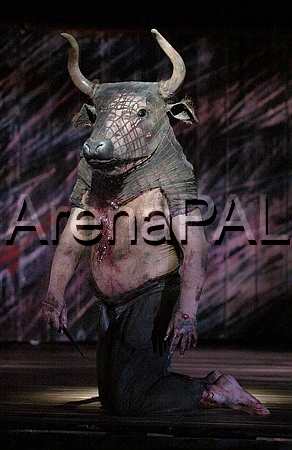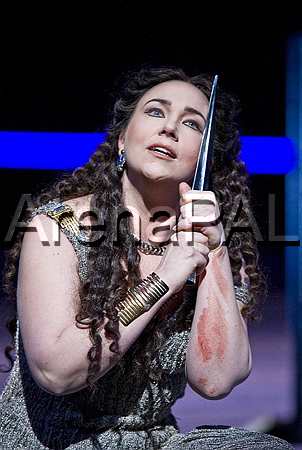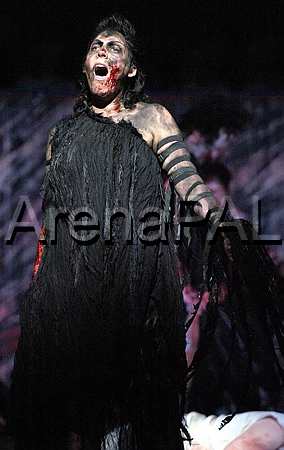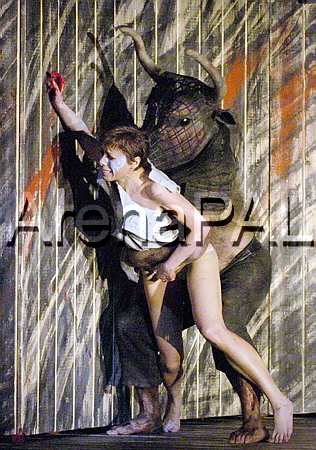 On the whole I don't "do" modern opera. Last week, I was tipped the wink that this was definitely worth seeing. I perused the available reviews and decided to take the plunge, booking tickets for Jimmy and me. As I decided to take advantage of the 'best seats in the house for £65' deal, it wasn't a cheap evening, but sometimes it's fun to get a taste of how the other half live. (Normal price £180, rising to £210 for some productions next season). I gave Jimmy a let-out clause that if he really didn't like, he must tell me at half-time.
On the whole I don't "do" modern opera. Last week, I was tipped the wink that this was definitely worth seeing. I perused the available reviews and decided to take the plunge, booking tickets for Jimmy and me. As I decided to take advantage of the 'best seats in the house for £65' deal, it wasn't a cheap evening, but sometimes it's fun to get a taste of how the other half live. (Normal price £180, rising to £210 for some productions next season). I gave Jimmy a let-out clause that if he really didn't like, he must tell me at half-time.
In the event, he really enjoyed it, exponentially more than whisper it quietly Tamerlano in Madrid.
It's due to be on radio in a few weeks. Having seen it live, I will probably listen to the broadcast, but I know I won't enjoy it anything like as much. I suspect I might find it peculiar, because the music and the drama went so well together. To be honest, even with very familiar operas, I find radio to be a poor substitute. I get so tired by the dinosaurs on Opera-hell and elsewhere who judge an opera, or its performance, by a radio hearing. It makes me laugh when people say 'at least with radio I can imagine my own pictures'. Yes, that works with books, but not with opera or stage-plays any more than it does for Fine Art. And it's contrary to the composer's intentions.
So, the Minotaur. I know the story pretty well. Or at least, I thought I did. What I actually know is the story as appropriately abridged in the Junior 2 (now Year 4) reading book. So this production was fabulous in filling in the rich detail.
Firstly, the music. By Harrison Birtwhistle. I really liked it. I wouldn't pretend that I came out humming the tunes but that wasn't the purpose. I practically came on the spot when I took my seat and realised that both front boxes were filled with percussion instruments. Oh how cool is this going to be. There was never a point where I found the music unpleasant. I have read that it's atonal. Although I have read and theoretically understand what atonal means, I am not able to hear something and say sagely, "It's atonal". For me, either it works or it doesn't. And it worked. I suppose what I liked was the way the music was used in some places as sound effects. I also enjoyed the percussion for its own sake, and noticed the flutes in particular from the 'Other Instruments'.
The singing was of a universally high standard. Perhaps it helps in not actually knowing the work, but there were fine performances from the leading roles right down to the bit parts. It wasn't just the singing, though. It was like that was the icing on the cake. It would have been a fraction of what it was if they had just parked-and-barked, which is, of course, what we will get on the radio.
 For me, the stand out was Christine Rice. She was sensational. Vocal expression and colour, really convincing as Ariadne, facially expressive and she moved superbly on stage. She portrayed different aspects well. The - albeit reluctant - loving sister, the dignified woman, the girl desperate to get away from a living hell. She was particularly impressive when she narrated the story of how her mother had lain with the sea-bull and then gave birth to the half-and-half. Earthy and literal, and very feminine.
For me, the stand out was Christine Rice. She was sensational. Vocal expression and colour, really convincing as Ariadne, facially expressive and she moved superbly on stage. She portrayed different aspects well. The - albeit reluctant - loving sister, the dignified woman, the girl desperate to get away from a living hell. She was particularly impressive when she narrated the story of how her mother had lain with the sea-bull and then gave birth to the half-and-half. Earthy and literal, and very feminine.
John Tomlinson was a tour de force as the Minotaur. He played his entire role with a bull's head over his own head. It was a fascinating contraption, because from some angles you could tell it was a frame covered by a net, but mainly it looked like a solid bull's head. He was shirtless, his whole body from the waist up covered with hair - reportedly he was wearing a hair-covered vest although that wasn't obvious even from the fourth row of the stalls. I wasn't entirely sure what was going on in the trouser department, save that he had an large dildo outside his trousers. The outfit was complemented by the barefoot look. His movements were fascinating: well choreographed and well executed, often very convincing imitation of how cattle move. I don't think I could ever love his voice but the range of emotions he conveyed was startling, from anger and lust to self-pity and pathos.
Johann Reuter was good as Theseus. Not really in the class of Christine Rice and John Tomlinson, but never less than satisfying. When he went into the labyrinth he removed his jacket; when he got to fight, he also removed his vest. Definitely one to add to the barihunks list. He also displayed considerable athleticism.
 There was strength in depth, including Andrew Watts as the snake priestess, singing whilst on stilts and wearing a set of comedy false boobs, Philip Langridge in a basically cameo role as the priestess's asistant (his son was the stage director). Rebbeca Bottone sang and acted superbly as the First Innocent; all the Innocents were good. And I developed a minor girly crush on Amanda Echalaz as Kere, leader of the vultures. That is quite some voice, soaring high into the stratosphere. Also convincing dance moves and great looking.
There was strength in depth, including Andrew Watts as the snake priestess, singing whilst on stilts and wearing a set of comedy false boobs, Philip Langridge in a basically cameo role as the priestess's asistant (his son was the stage director). Rebbeca Bottone sang and acted superbly as the First Innocent; all the Innocents were good. And I developed a minor girly crush on Amanda Echalaz as Kere, leader of the vultures. That is quite some voice, soaring high into the stratosphere. Also convincing dance moves and great looking.
The production was memorable. It would be interesting to discover, with a new opera like this, how much interaction there is between librettist, composer and director, how much it is a dialectic process. It opened with a video projection of waves as if shot from the bow of a ship. This returned at appropriate orchestral interludes.
Above ground much of the action took place at the front of the stage where there was what seemed to be a sand pit, and the head of a bull created by Daedalus. In the first act a ship was moored at the back of the stage; from here emerged the innocents.
Underground, the labyrinth varied depending upon whether the Minotaur was awake or asleep. When he was awake, a crowd of masked Furies, including two on-stage timpanists, were arrayed behind a low wall, urging him on to kill the Innocents. Asleep there was a mirror/video projection screen, at which various times appeared the Minotaur's reflection, or his video projection, and Ariadne and Theseus. When people entered the labyrinth the descended down through a trapdoor into the bowels of the stage and in the next scene they descended ladders from the flies.
Most impressive was the choreography, especially of the Innocents and the Keres. The Keres in particular, a bit reminiscent of Valkyries.
 It was a brutal and gory production, the third this year (after Lucia, at ENO, and Salome) where the stage was awash with blood. The Innocents were gored; at times this could have been sharpened up. I think the idea was that as they removed their hands from their wounds, the blood gushed forth. However, it seemed almost like a ritualistic bursting of stage-blood capsules. The First Innocent was gored until she was convulsing a painful death; still alive she was raped, and when she was dead, the Half-and-Half eviscerated her vital organs. There was real attention to detail - for example, after he had raped her, he leaned against the wall, spent and sated. It is relatively rare for a dramatic depiction of sex to include the male 'roll-over and snore'.
It was a brutal and gory production, the third this year (after Lucia, at ENO, and Salome) where the stage was awash with blood. The Innocents were gored; at times this could have been sharpened up. I think the idea was that as they removed their hands from their wounds, the blood gushed forth. However, it seemed almost like a ritualistic bursting of stage-blood capsules. The First Innocent was gored until she was convulsing a painful death; still alive she was raped, and when she was dead, the Half-and-Half eviscerated her vital organs. There was real attention to detail - for example, after he had raped her, he leaned against the wall, spent and sated. It is relatively rare for a dramatic depiction of sex to include the male 'roll-over and snore'.
Most of all, the enduring impression was of pathos and compassion. I would be interested to know the origin of this myth. Obviously, it would be impossible for a half-man half bull to have been conceived and born, but I would guess that this was based on some grotesquely malformed and mentally subnormal offspring, perhaps the product of repeat in-breeding, who had to be contained, and hidden from sight. Considering that the hideousness was apparent at birth, it is some surprise that infanticide didn't occur. I had previously considered the Minotaur to be a monster, not deserving of our sympathy, but I came away with tremendous sympathy; indeed I cried. His life was so miserable he just wanted to die. He attributed his anger and lust to his human half. Ariadne had some love for him. He never saw daylight, never had the chance to run around in a field, and certainly would never find love to give or receive.
Just as a bonus, I came face to face with Harrison Birtwhistle in the interval.
Before the interval there were some longeurs but the fifty five minutes afterwards flew by so quickly. In those very few slower bits i fell to contemplating how this could be performed in a Met-trash style. Later, I came up with the solution and posted to a newsgroup (I have amended it slightly, subsequently...)
Excitingly, we were talking to Tony, Elaine and Harry in the Marquis afterwards and they're hoping to revive it for the 2012 Olympic Season, which is going to be all Greek mythology. However, because they wish to attract tourists, they're going to get a different director in. So that all the Innocents will be wearing designer Empire Line frocks or breeches and brocade waistcoats. Rather than raping, mauling and eviscerating his victims, the Minotaur will tell them of his angst. The vultures circling for blood will be replaced by angels. Rather than a black sail of death, the ship will have a pastel shaded sail. And the labyrinth will be less a subterranean hellhole and more Hampton Court. It's a bit tentative at the moment, but it's looking like Bryn will play the role of the very hairy bass-baritone bull (with Erwin Schrott on standby for the inevitable Terfel cancellation) They're hoping that as Katherine Jenkins will be over thirty by then and thus an opera singer she can take on the role created by Christine Rice. Rather than slaughtering a live pigeon, fresh from Covent Garden Piazza, live, on stage and smearing the blood over the scenery,she could partake of a ritual offering up of rose-petals in lavender water. And because the music is quite loud, almost raucous in places, it could be performed on baroque instruments, with the percussion merely mimed.
There are still three performances left and I would seriously recommend a visit. I don't know whether it will be televised; I hope so. If not, I hope that it will be revived soon. I don't know much about the Olympic Season and I am totally making it up that it will be about Greek myths, but it would be ace if the Cultural Olympics got comprehensive TV coverage.
Photos at ArenaPal
